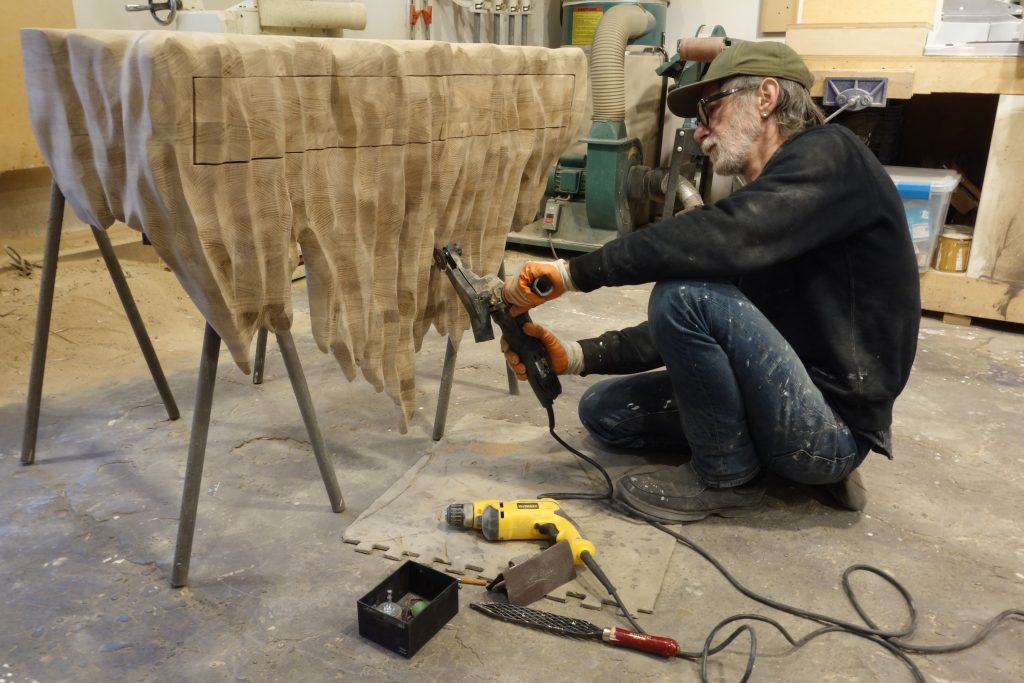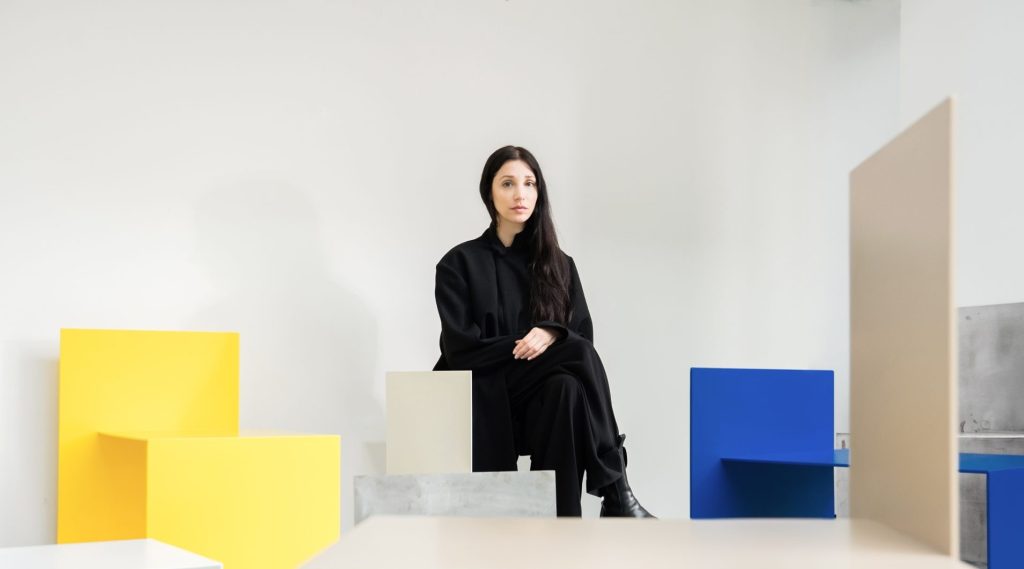
Studio Lél: Preserving Heritage by Painting in Stone
“I seek to draw the world’s attention to Peshawar’s layered history, its importance in the region and the fine craftsmanship that has existed and flourished here for centuries – encouraging new perspectives of Peshawar within its citizens and from abroad.”
– Meherunnisa Asad, Creative Director of Studio Lél
View Studio Lél’s Showroom, including the “Puvvi” Twirl Tables
Different stones, mostly semi-precious, are carefully selected according to their structure, texture, and color, cut and assembled into a picture – “painting in stone”.
This process is what Farhana Asad, Meherunnisa Asad, and a small group of local craftsmen and refugee artisans do at Studio Lél, an artistic collective in Peshawar, Pakistan. Lél was founded by Farhana in the late 1990s after an intriguing encounter with the technique at a bazaar in northern Pakistan and is currently managed with her daughter, Meherunnisa, as the creative director. The studio focuses on the art of pietra dura, a technique of inlaid stonework with roots going back to Ancient Roman times. With only a few artisans left trained in this craft, Studio Lél wants to preserve and evolve it, translating the technique for the contemporary world while celebrating its origin and heritage.
Surrounded by antiques while visiting the bazaars of Peshawar and with frequent visits of artisans to her family home, Meherunnisa Asad developed an interest and appreciation for traditional crafts. The architect and artist followed her interests in art and design, studying at the National College of Arts, Lahore and the Pratt Institute, New York City to develop the academic foundation which she now applies in her current work. As the creative director of Lél, Meherunnisa combines her passion for the ancient craft of pietra dura with her innate passion to preserve and reinterpret traditional craft for a global audience.
Following in the craft’s tradition of predominantly floral and nature-inspired motifs, Studio Lél produces a range of objects, including furniture, tableware, and wall decorations. Monochromatic stones – for example, white or black marble – used for the background of pieces like the “Champa” Nesting Tables or “Reidi” Bowl make the vivid colors of inlaid semi-precious stones used for the motifs appear even brighter. In doing so, unlike a mosaic, the gaps between the individual stones seem invisible; artisans must work very precisely to ensure the stones fit together perfectly. As an art form, pietra dura requires patience until the right stone has been found and whose quality is expressed through persistence.
Studio Lél has a strong connection with refugees and local craftsmen. Could you explain how this relationship came to be?
When refugees cross borders, they bring tangible and intangible parts of their culture with them. Crafts, I believe, have the power to re-construct identity.
Lél was founded by my mother, Farhana Asad, three decades ago. While she browsed the bazaars of Peshawar, a city in Northern Pakistan, she came across an exquisite box and became fascinated with the technique of inlaid stonework known as parchin kari or pietra dura. She eventually tracked down its maker, an Afghan craftsman who agreed to give her lessons in the technique in our garage at home. Ever since the Lél artist collective has opened its doors to both local craftsmen and artisans escaping the war across the border and worked to preserve the craft’s knowledge and skills for future generations, as well as exploring the creative possibilities of the technique.
Even during the height of the Taliban insurgency in the early 2000s, when bomb blasts rattled the studio windows, the Lél workshop has remained operational. We all lost a friend or relative at that time. But the work became a way of pushing back, changing the narrative. I see this act of preservation as a healing mechanism. A belief in something that is beyond the region’s sustained conflict and migration. It enforces the power of craft to shape and re-construct an identity that is being lost to war and conflict.




What is it about the inlaid stonework technique of pietra dura – Studio Lél’s specialty – that specifically drew you to it?
Originating out of the ancient Roman opus sectile technique the art of pietra dura, or stone inlay – also referred to as parchin kari in South Asia – found not only its revival but also reached its highest pinnacle of development, in the hands of the Florentines during the Italian Renaissance of the 16th century. To them, this act of the meticulous cutting and fitting of stones into intricate and exquisite forms was synonymous with the act of painting – “painting in stone”. Within the century, pietra dura would find its spread extending to Russia, Iran, and across into Afghanistan, India, and Pakistan, under the patronage of the Great Mughal Empire which facilitated cultural and artistic bridges between Europe, the Middle East, and South Asia.
What fascinates me about this exquisite and complex art form is the fact that each piece of stone has a unique form, color, and texture. The process of creation does not start in the workshop, but rather in the mountains millions of years ago. Furthermore, pietra dura is a zero-waste technique. There is no such thing as workshop waste as one is able to use all the different parts of the stone, making it a highly sustainable art form.








Although pietra dura is a technique that dates back to the 16th century, Studio Lél is determined to evolve the artform. How is this evolution manifested in the studio’s practice?
The classic form of pietra dura has been re-imagined and re-cast at the Lél workshop over the past three decades in a unique way that was never done before in the history of this art form. At the heart of this re-imagination is the ancient town of Peshawar, its bazaars and its central location as a key hub along the historic silk route. It has always been a city that has attracted traders, craftsmen, and storytellers from lands as far away as China in the east and Europe in the west.
Verre Eglomise is a well-known French glass painting art form, of which several works were found in the bazaars of Peshawar. Similarly, one came across many fine decoratives using the Chinese Cloisonne technique of encircling cut-outs with fine metal. Scagliola objects were also found in the same bazaars, which is a cost-effective substitute to more expensive pietra dura pieces of art since it uses composite substitutes that imitate real stone and marble.
In the Lél studio and its workshops, a unique process has been developed and mastered to create a confluence of these three techniques with pietra dura, which has led to the creation of timeless pieces. The “Music of the Macaws” depicts a scene of the forest where Verre Eglomise highlights the multicolored wings of the birds, whereas many uniquely shaped leaves are encased by the definition of cloisonne and the background of the sky is created through the scagliola technique. Moreover, resin is another technique that became popular in the mid-20th century and grew out of industrial use, but at the studio, we have integrated that into this masterpiece as well and parts of the foliage are accentuated through this technique. The result of this process is the creation of a one of kind masterpiece.




With reference to Studio Lél’s space in the collectible design market, what do you envision in the future of the studio’s practice?
In the future, the studio will be launching collections rooted in a contemporary aesthetic while staying true to its origins of focusing on singularity, craftsmanship, and story-telling. Lel’s future will also continue to rely on its commitment to continue innovating with master artisans and flowing in directions lead by the creative spirit as well as skill and expertise. International collaborations that push the boundaries of the medium are in the pipeline.




What are you most excited to share with the ADORNO audience about Studio Lél?
I am excited to share “The Sunflowers are Mine”, a recently completed art commission that merges the Mughal pietra dura adornment tradition of using rubies, emeralds, and other precious gems in combination with semiprecious and hard stones.
In addition, I am also excited to share “The Together Apart” collectible design series that attempts to deconstruct Van Gogh’s post-impressionist style of painting. This deconstruction is nestled in Studio Lél’s unique techniques and innovations described earlier. Moreover, the deconstructed appearance of works from this series is also rooted in the ethos of the reality of Peshawar and Afghanistan where displacement and dispossession are key and recurrent themes for decades.
Bio
Studio Lél is a Peshawar-based artistic collective dedicated to preserving and re-interpreting the 16th century Italian and Mughal art of Pietra Dura also known as stone inlay. Lél’s work may very well represent the gray space between fine art, design and craft.
Lél’s founder, Farhana Asad, became fascinated by the technique of inlaid stonework when she came across an exquisite box in a bazaar in northern Pakistan 30 years ago. She eventually tracked down its maker, an Afghan craftsman who agreed to give her lessons in the technique in her garage at home. Ever since, the Lél artist collective that Asad founded has opened its doors to both local craftsmen and those escaping the war and worked to preserve the craft’s knowledge and skills for future generations.
At the Lél workshop, the creative possibilities of the art form are explored further by incorporating other techniques such as the French verre églomisé (glass gilding), the Chinese cloisonné (enameling) and epoxy resins. Its master craftsmen work alongside metal and woodworkers for its art works and designer objects.
–
Lél’s Creative Director, Meherunnisa Asad, is a Peshawar-born architect and artist. Asad is a graduate of the National College of Arts, Lahore and Pratt Institute, New York City. On her return to Pakistan from the United States, Asad worked as lead conservation architect at the Aga Khan Historic Cities Program on the Conservation of the Lahore Walled City Project. Asad has an innate passion to promote traditional craft from Pakistan and re-interpret it for the global audience. She has carried Lél from its humble origins to an internationally acclaimed studio that has exhibited at major design shows.
From an early age Asad was surrounded by art and design. The fabled bazaars of the historic city of Peshawar were a few kilometers away and many an afternoon were spent rummaging through art galleries and antique shops with her mother and siblings.
These childhood experiences piqued her interest in traditional art forms which was further crystalized as her mother engaged informally with displaced Afghan master artisans of Pietra Dura in her garage at home. As the artisans became frequent visitors to Asad’s home, she started to develop a keen interest in not only the preservation of the techniques but also in the stories of the artisans who created these pieces.









